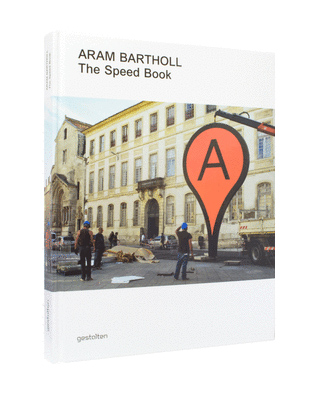Solo Show Opening & Book Launch at [DAM] Berlin, Jan 27
… the announcement below is stolen from the [DAM] Berlin website. Expect a couple new pieces, exclusive offline art for the opening!! (… to be published online soon after), lots of DIY and the ARAM BARTHOLL book launch!! I am very excited about all this, hope you can make it!! CU in 2 weeks !! 🙂
Aram Bartholl
Reply All
[DAM] Berlin, Neue Jakobstr. 6/7, 10179 Berlin
Performance “How to Vacuum Form” by Aram Bartholl
19:30 Uhr: Book launch of Bartholl’s first monograph Aram Bartholl – The Speed Book, which will be published by Gestalten Verlag. The publisher, art critic and curator Domenico Quaranta gives the introduction.
Exhibition: January 28th – March 10th 2012
———————————————————–
Gallery [DAM]Berlin presents Berlin based artist Aram Bartholl (*1972, Bremen) in his first solo exhibition, whose works create a dynamic tension between online- and real-life. In 2011 Bartholl was partaking in exhibitions by MoMA, Pace Gallery New York and [DAM]Cologne.
His pieces are cutting-edge – not just product of observation, but formed by thought-provoking impulses that Aram gives and by the subsequent independent existence of the artworks created by the user. His interventions in public space, his readymade-like installations and sculptures are based on a do-it-yourself-culture with regard to personal creation and responsibility as well as the Internet’s popular icons with whom Bartholl confronts us in reality. But Aram Bartholl’s artworks are not to be seen as entirely digital: they deal too much with space, are too haptic in their approach, and the awareness of potential political influence is too intense – his pieces push out of gallery and museum surroundings into the city space, into society.
Things, that seem to be trivial parts of the internet, irritate the viewer as soon as they confront him in the physical world: In Are you human? a CAPTCHA-code, used by web services to differentiate between human request and automated scripts, is applied in aluminium form onto murals and gallery walls. A screen with illuminating pixels turns out to be a hand crafted object operated by a candle. In a subtle but accurate way Bartholl reveals discourses concerning the power of a digitally affected world, e.g. in his successful, often quoted project Dead Drops, consisting of USB-sticks, mured into city walls, that refuse data exchange via the internet structures established by big global companies.
‘Everything develops extremely fast on the net. I have the urge to create something that deals with the topic, but that endures anyway,’ says Aram Bartholl about this de-digitalisation of the digital. Where media art, urban intervention and interactive performance meet he asks basic sociocritical questions, thinks about our cultural memory. The rapid development of the digital age is slowed down in his artworks, it is liberated of its technological appeal and exposed for intentional examination. For example his new project Dust: Bartholl wants to convey the worlds most played computer game landscape from Counter Strike – a virtual space, a place seen by millions of people that is fixed in their visual memory even though they were never able to really ‘enter’ it – into an accessible 1:1 model made of concrete.
With the performance and installation shown at the exhibition for the first time, Bartholl, who is active in net political circles like the Chaos Computer Club, turns towards the symptom of an already existing frontier crossing of digital and analogue world: The Anonymous-movement and its characteristic comic-inspired Guy-Fawkes-masks, that are its distinctive mark and protection of identity. They have gained huge media presence thanks to the civil movement Occupy Wallstreet as well. The Anonymous-movement pushes forward the idea of a free, net-based information- and creativity-collective – a kind of global brain, that develops political capacity to act without hierarchic organisation and without determined identity.
The exhibition ‘Aram Bartholl. Reply All’ is part of the associate programme of Transmediale 2012.
———————————————————-
ARAM BARTHOLL
The Speed Book
- Publisher: gestalten
Editor: Domenico Quaranta
Design: Manuel Bürger
- Release Date: January 2012
- Format: 21,6 x 28 cm
- Features: 268 pages, full color, hardcover
- Language: English
https://shop.gestalten.com/aram-bartholl.html
With essays by:
Josephine Bosma,
Jonah Brucker-Cohen,
Jon Cates,
Lindsay Howard,
Alessandro Ludovico,
Evan Roth,
Bruce Sterling,
Brad Troemel
About This Book
Aram Bartholl: The Speed Book features savvy experiments with transitions from the virtual to the physical: USB sticks embedded into walls, buildings, and curbs; giant real-life versions of Google’s red map markers positioned in public spaces; portraits generated from search results. An introduction by editor Domenico Quaranta as well as essays by science fiction writer Bruce Sterling, art critics, and fellow artists guide readers through a wonderfully skewed version of reality under the influence of the internet, something Sterling refers to as Bartholl’s “self-created twilight zone.”
More About This Book
This first comprehensive monograph offers entry to Bartholl’s entertaining art in which space and cyberspace mingle and mangle each other—a realm that uses as little technology as possible while still speaking a digital language.
Aram Bartholl: The Speed Book features savvy experiments with transitions from the virtual to the physical: USB sticks embedded into walls, buildings, and curbs; giant real-life versions of Google’s red map markers positioned in public spaces; portraits generated from search results. An introduction by editor Domenico Quaranta as well as essays by science fiction writer Bruce Sterling, art critics, and fellow artists guide readers through a wonderfully skewed version of our society under the influence of the internet, something Sterling refers to as Bartholl’s “self-created twilight zone.”
